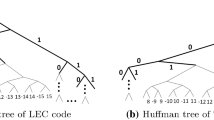Abstract
In this paper, a hybrid data compression scheme based on predictive compressed sensing (CS) and light weight lossless compression is suggested for wireless sensor networks (WSNs). CS based techniques are well motivated in WSNs not only for sparse signals but also by the requirement of efficient in-network processing in terms of transmit power and communication bandwidth even with nonsparse signals. This algorithm exploits prediction-based approach in which the difference between the actual measurements and the predicted measurements of the dataset is encoded using CS technique with reasonable error. The CS encoded data is further compressed using Huffman encoding to improve the compression ratio without any loss in quality. We analyzed the performance, data rate saving and inaccuracy introduced by the hybrid compression algorithm. The post processing analysis shows high compression ratios, with acceptable mean squared error.





Similar content being viewed by others
References
David, L. (2009). Donoho, “Compressed sensing.” IEEE Transactions On Information Theory, 52, 1289–1306.
Machiwal D., & Jha, M. K. (2012) Stochastic modelling of time series. In: Hydrologic time series analysis: Theory and Practice. Dordrecht: Springer. https://doi.org/10.1007/978-94-007-1861-6_5
Tealab, A. (2018). Time series forecasting using artificial neural networks methodologies: A systematic review. Future Computing and Informatics Journal, 3(2), 334–340.
Yadav, S., & Kumar, V. (2019). Hybrid compressive sensing enabled energy efficient transmission of multi-hop clustered UWSNs. AEU-International Journal of Electronics and Communications, 110, 152836.
Srisooksai, T., Keamarungsi, K., Lamsrichan, P., & Araki, K. (2012). Practical data compression in wireless sensor networks: A survey. Journal of Network and Computer Applications, ELSEVIER, 35, 37–59.
Luo, H., Tong, Y. C., & Pottie, G. (2005). A two-stage DPCM scheme for wireless sensor networks. In Proceedings. (ICASSP’05). IEEE International Conference on Acoustics, Speech, and Signal Processing, 3, 661–664.
Medeiros, H. P., Maciel, M. C., Demo Souza, R., & Pellenz, M. E. (2014). Lightweight data compression in wireless sensor networks using Huffman coding. International Journal of Distributed Sensor Networks, 10(1), 672921.
Marcelloni, F. (2008). Massimo Vecchio, A simple algorithm for data compression in wireless sensor networks”. IEEE Communications Letters, 12, 411–413.
Kolo, J. G., Shanmugam, S. A., Lim, D. W. G., Ang, L. M., & Seng, K. P. (2012). An adaptive lossless data compression scheme for wireless sensor networks. Journal of Sensors, 2012(2012), 1–20. https://doi.org/10.1155/2012/539638
Parnasree Chakraborty, C. (2015). Tharini, “analysis of suitable modulation scheme for compressive sensing algorithm in wireless sensor network”, sensor review (ISSN: 0260–2288). Emerald Group Publishing Limited, 35(2), 168–173.
Chakraborty, P., & Prasad, T. (2018). ”An efficient communication protocol for wireless sensor network using differential encoding based compressed sensing technique”, international journal of circuits, systems and signal processing ( ISSN: 1998–4464). NAUN publication, 12, 356–366.
Climate Data Online: Dataset Discovery. Available: https://www.ncdc.noaa.gov/cdo-web/datasets. Accessed 20 Aug 2021.
Why small L1 norm means sparsity? (2016). Available: https://math.stackexchange.com/questions/1904767/why-small-l1-norm-means-sparsity. Accessed 20 Aug 2021.
How to define sparseness of a vector? (2017). Available: https://math.stackexchange.com/questions/117860/how-to-define-sparseness-of-a-vector. Accessed 20 Aug 2021.
Masoum, A., Meratnia, N., & Havinga, P. J. (2013). A distributed compressive sensing technique for data gathering in wireless sensor networks. Procedia Computer Science, 21, 207–216.
Karakus, C. (2013). Ali Cafer Gurbuz, Bulent Tavli, “analysis of energy efficiency of compressive sensing in wireless sensor networks.” IEEE Sensors Journal, 13, 1999–2008.
Chakraborty, P., & Chandrapragasam, T. (2021). Extended applications of compressed sensing algorithm in biomedical signal and image compression. Journal of the Institution of the Engineers India Series B. https://doi.org/10.1007/s40031-021-00592-8
Gurve, D., Delisle-Rodriguez, D., Bastos-Filho, T., & Krishnan, S. (2020). (2020) Trends in Compressive Sensing for EEG Signal Processing Applications. Sensors (Basel), 20(13), 3703. https://doi.org/10.3390/s20133703
Kumar, P., & Parmar, A. (2020). Versatile approaches for medical image compression: A review. Procedia Computer Science, 167, 1380–1389. https://doi.org/10.1016/j.procs.2020.03.349.
Acknowledgements
The authors would like to thank their supporting educational institution for providing infrastructure facilities and licensed software to carry out the work.
Author information
Authors and Affiliations
Corresponding author
Ethics declarations
Conflict of interest
The authors declare that there is no conflict of interest.
Additional information
Publisher's Note
Springer Nature remains neutral with regard to jurisdictional claims in published maps and institutional affiliations.
Rights and permissions
About this article
Cite this article
Chakraborty, P., Tharini, C. Integration of Prediction Based Hybrid Compression in Distributed Sensor Network. Wireless Pers Commun 122, 229–241 (2022). https://doi.org/10.1007/s11277-021-08896-0
Accepted:
Published:
Issue Date:
DOI: https://doi.org/10.1007/s11277-021-08896-0




